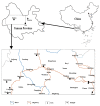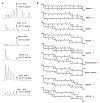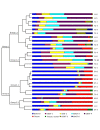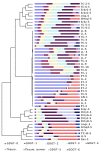Impacts of temperature and pH on the distribution of archaeal lipids in Yunnan hot springs, China
- PMID: 24194734
- PMCID: PMC3812992
- DOI: 10.3389/fmicb.2013.00312
Impacts of temperature and pH on the distribution of archaeal lipids in Yunnan hot springs, China
Abstract
In culture experiments and many low temperature environments, the distribution of isoprenoid glycerol dialkyl glycerol tetraethers (GDGTs) commonly shows a strong correlation with temperature; however, this is often not the case in hot springs. We studied 26 hot springs in Yunnan, China, in order to determine whether temperature or other factors control the distribution of GDGTs in these environments. The hot springs ranged in temperature from 39.0 to 94.0°C, and in pH from 2.35 to 9.11. Water chemistry including nitrogen-, sulfur-, and iron species was also determined. Lipids from the samples were analyzed using liquid chromatography-mass spectrometry (LC-MS). Distributions of GDGTs in these hot springs were examined using cluster analysis, which resulted in two major groups. Group 1 was characterized by the lack of dominance of any individual GDGTs, while Group 2 was defined by the dominance of GDGT-0 or thaumarchaeol. Temperature was the main control on GDGT distribution in Group 1, whereas pH played an important role in the distribution of GDGTs in Group 2. However, no correlations were found between the distribution of GDGTs and any of the nitrogen-, sulfur-, or iron species. Results of this study indicate the dominance of temperature or pH control on archaeal lipid distribution, which can be better evaluated in the context of lipid classification.
Keywords: Archaea; GDGTs; Yunnan; hot springs; organic proxies; pH; temperature.
Figures







Similar articles
-
Distribution of ether lipids and composition of the archaeal community in terrestrial geothermal springs: impact of environmental variables.Environ Microbiol. 2015 May;17(5):1600-14. doi: 10.1111/1462-2920.12595. Epub 2014 Oct 13. Environ Microbiol. 2015. PMID: 25142282
-
Factors controlling the distribution of archaeal tetraethers in terrestrial hot springs.Appl Environ Microbiol. 2008 Jun;74(11):3523-32. doi: 10.1128/AEM.02450-07. Epub 2008 Apr 4. Appl Environ Microbiol. 2008. PMID: 18390673 Free PMC article.
-
Archaeal and bacterial glycerol dialkyl glycerol tetraether lipids in hot springs of yellowstone national park.Appl Environ Microbiol. 2007 Oct;73(19):6181-91. doi: 10.1128/AEM.00630-07. Epub 2007 Aug 10. Appl Environ Microbiol. 2007. PMID: 17693566 Free PMC article.
-
Archaeal Lipids: Extraction, Separation, and Identification via Natural Product Chemistry Perspective.Int J Mol Sci. 2025 Mar 29;26(7):3167. doi: 10.3390/ijms26073167. Int J Mol Sci. 2025. PMID: 40243902 Free PMC article. Review.
-
Microbial Diversity of Terrestrial Geothermal Springs in Armenia and Nagorno-Karabakh: A Review.Microorganisms. 2021 Jul 9;9(7):1473. doi: 10.3390/microorganisms9071473. Microorganisms. 2021. PMID: 34361908 Free PMC article. Review.
Cited by
-
Carbon Oxidation State in Microbial Polar Lipids Suggests Adaptation to Hot Spring Temperature and Redox Gradients.Front Microbiol. 2020 Feb 20;11:229. doi: 10.3389/fmicb.2020.00229. eCollection 2020. Front Microbiol. 2020. PMID: 32153529 Free PMC article.
-
Heat Stress Dictates Microbial Lipid Composition along a Thermal Gradient in Marine Sediments.Front Microbiol. 2017 Aug 22;8:1550. doi: 10.3389/fmicb.2017.01550. eCollection 2017. Front Microbiol. 2017. PMID: 28878741 Free PMC article.
-
Archaeal lipids trace ecology and evolution of marine ammonia-oxidizing archaea.Proc Natl Acad Sci U S A. 2022 Aug 2;119(31):e2123193119. doi: 10.1073/pnas.2123193119. Epub 2022 Jul 29. Proc Natl Acad Sci U S A. 2022. PMID: 35905325 Free PMC article.
-
Tracking hydrothermal infiltration within light oil reservoirs using organic geochemical proxies in the Shunbei area of Tarim Basin in China.Sci Rep. 2025 Jan 12;15(1):1759. doi: 10.1038/s41598-025-85485-2. Sci Rep. 2025. PMID: 39800755 Free PMC article.
References
-
- Buckles L. K., Villanueva L., Weijers J. W. H., Verschuren D, Sinninghe Damsté J. S. (2013). Linking isoprenoidal GDGT membrane-lipid distributions with gene abundances of ammonia-oxidising Thaumarchaeota and uncultured crenarchaeotal groups in the water column of a tropical lake (Lake Challa, East Africa). Environ. Microbiol. 15 2445–2462 10.1111/1462-2920.12118 - DOI - PubMed
LinkOut - more resources
Full Text Sources
Other Literature Sources

